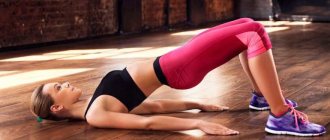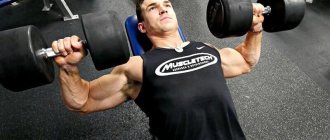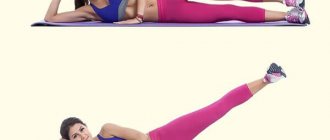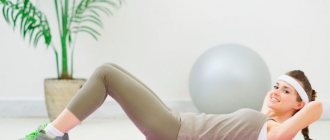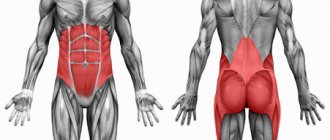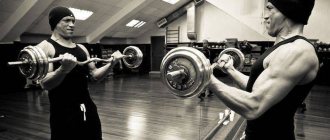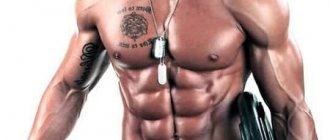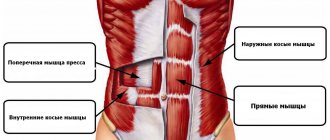Abdominal muscle structure:
We humans are all the same. Our muscle set is the same as that of any other person. This also applies to the abdominal cavity. These muscles are responsible for the following functions:
- Form the abdominal wall
- Protects and keeps internal organs in a stable position
- Support our body and form correct posture
Abdominal muscles:
- Rectus muscle
- Oblique (external and internal)
- Transversus muscle
It is conventionally accepted to divide these abdominal muscles into special groups, such as the anterior, lateral and posterior walls of the abdomen.
Side stretch in pairs
What muscles are we stretching: obliques, latissimus dorsi, quadratus lumbar muscles.
Performance. Stand with your partner side to side at a distance of about one step, feet together. Grasp each other's forearms on the inside, raise your hands on the outside and clasp your palms together, forming an arch. From this position, gently bend away from your partner, stretching the outer side of your body. The legs should not leave the floor or change position.
A comment. It is advisable that you do not differ much from each other in height and weight, otherwise the exercise will not be very convenient and effective. The main goal is to stretch the entire side, including the glutes, obliques, and latissimus dorsi.
Rectus abdominis muscle:
So, this muscle, by its specificity, is flat and long, consists of special, thin bundles of muscles that are located vertically. It is this muscle that those who dream of expressive abs love so much. It starts from the chest, runs along the entire abdomen, and is attached at the end to the pelvic bone. A special layer of connective tissue, or the linea alba, divides the rectus muscle into two parts.
Main function:
- Twisting of the body in the lumbar spine
- Raising the pelvis with a fixed chest
- Increased intra-abdominal pressure
- Lowering the ribs, exhale
The rectus abdominis muscle is endowed with great capabilities in terms of lifting force and cross-section. It acts as a powerful flexor of our spine. It is worth noting that in the process of fixing the chest and during its contraction, the pelvis rises, and not lowers the chest in its direction.
The rectus muscle has an interesting feature - it can contract in separate areas, and not all at once. Because of this condition, you can focus your training program on individual areas of this muscle, selecting the necessary exercises.
What problems are possible?
The transverse abdominal muscles may ache due to physical strain, causing aching pain. Sometimes discomfort appears suddenly, accompanied by weakness and hyperthermia. This usually happens with myalgia. The condition is preceded by increased muscle tone.
Typical diseases that cause discomfort in the abdominal muscles:
- pancreatitis, cholecystitis, appendicitis;
- perforation of intestinal, gastric ulcers;
- tumor in the pelvic area, aneurysm perforation, cystic formations;
- acute intestinal obstruction, circulatory disorders;
- strangulation of a hernia of the white line of the peritoneum;
- stretching, complete or partial rupture of the peritoneal muscles.
Painful sensations in the permanent breast of an aching nature are still possible in the perinatal period; they arise due to natural muscle stretching due to an enlarged uterus. Women who lead a passive lifestyle in the second trimester are susceptible to the phenomenon.
External oblique muscle:
The peculiarity of this muscle is that it is considered the widest on the surface of our body and is located on both sides of our torso. Its fibers are arranged in such a way that they run from top to bottom and medially, to the midline of the body. It originates from the surface of the sternum on the side, or more precisely, from the 8 lower ribs. It is clearly depicted below.
Main function:
- Helps rotate our body in opposite directions (subject to unilateral contraction)
- Provides downward traction of the ribs, as well as flexion of the torso (subject to bilateral contraction)
- Helps with lifting and carrying various weights
- Keeps our body upright
Spinal twists with the help of a partner
What muscles are we stretching: oblique abdominal muscles.
Performance. Sit on a flat bench, back straight, bodybar (or bar) resting on your shoulders, you hold on to it at both ends (arms as wide as possible). Your partner stands behind you, grabs the bodybar in the same places where your hands are, and gently turns you to the side until you feel a stretch in the oblique abdominal muscles. Then return to the starting position, inhale and exhale and repeat the twist, but in the other direction.
A comment. Due to the tension in the rotator cuff muscles, this exercise cannot be performed correctly without assistance. To get the greatest effect, you should relax your abdominal muscles and exhale as you twist to the side.
To do this stretch on your own, place your hands behind your head and twist yourself from side to side. This can be done even while sitting at your desk.
Anatomy of the abdominal muscles: structure, functions, exercises for developing the abdominal muscles
The human body consists of a huge number of different muscles. A fairly large surface of the human body in front is occupied by the abdominal muscles. They also perform many important functions on which the optimal state of the human body as a whole depends. The most “perfect” in terms of evolution are the abdominal muscles. This fact once again emphasizes such an anatomical feature of the human body as its vertical position in space and another feature that distinguishes people from animals - upright walking. From the above it follows that a person needs strong abdominal muscles. They are also needed in order to protect the organs located inside the human body, various cavities, joints, cartilage and bones.
Progression
Movements that do not cause you much difficulty and are not accompanied by a period of fatigue will not bring any result except the calories burned.
In some cases this is useful, but our goal is to create a beautiful relief and strengthen the abdominal muscles.
Increasing the load is the only way to constantly progress. This can be achieved if:
- Use additional weight;
- Perform new movements;
- Work longer and faster.
The first option suits us best, because short but heavy approaches tire the nervous system less.
To work, we need something quite weighty; a barbell or dumbbell would be ideal.
Of course, you can even use an anvil, but it is not so convenient. You need to select weights so that you can perform 20 repetitions in compliance with the technique.
When you are tired, making movements similar to the spasms of a dying heron, it is worth stopping, since you are pumping the hernia rather than the abs.
To work with your legs, you can resort to tourniquets and elastic bands that create resistance.
Considering the functions of the abdominals, you need to choose exercises that require the work of the upper and lower body.
Classic complex:
- Twisting with weight 20X4;
- Leg raises with resistance 20X4;
- Lateral bends with a dumbbell 20X4 on each side;
- Slopes with a vertical block 20X3;
- Rivet 10X4.
This program has the following goals:
- Load your abs as much as possible with the first two approaches. When performing them, it is important to maintain smooth movement and not to involve the muscles of the back and buttocks in the work.
- Side bends with a dumbbell are not a difficult exercise, but they are not an area that needs to be worked to the maximum. Therefore, you should not take too much weight.
- Vertical block, the ideal exercise machine for the abdominal muscles. Working with it is quite simple and it allows you to slightly relax the nervous system and finish off already tired muscles.
- The rivet allows all tissues to be saturated with blood, which will contribute to the complete breakdown of lactic acid. As counterintuitive as it may be, by doing it at the end, you will recover faster and will not experience pain, or it will be minimized.
Best exercises
In terms of training, the anatomy of the abdominal muscles in men and women is no different, with the exception of the number of fast and slow fibers. Therefore, the training of this group is not divided into male or female. It is important to understand the specifics of performing exercises for the abdominal group. Despite the structure of the abdominal muscles and the fact that the rectus abdominis muscle is a single mass, it is customary to work it on both sides. This is due to the fact that the nerve endings that affect muscle contraction are located on different sides.
Complex exercises (work the top and bottom):
- Exercise "book";
- Simultaneous crunches while lying down with the elbow brought to the knee;
- Plank.
Upper press:
Lower press:
Oblique muscles:
- Raising legs while hanging with abduction to the sides;
- Twisting with body rotation (bringing the right elbow to the left knee and vice versa);
- Side plank;
- Exercise “Russian twist”.
Overall, to understand the role of exercise, you need to consider the anatomy of the abdominal muscles. Bringing the body to the legs engages the upper abdomen and vice versa, bringing the legs to the body engages the upper abs. For the oblique muscles, movements must necessarily include a rotation of the body.
Muscles that form the back of the abdomen
In fact, the back wall of the abdomen is formed by one muscle - the quadratus lumborum muscle. However, this muscle is paired.
Quadratus lumborum (musculus quadratus lumborum)
A flat, wide muscle, it covers a small part of the space between the 12th rib and the iliac crest. The quadratus muscle is separated from the back muscles by the lumbothoracic fascia, or more precisely, by its deep plate. This muscle looks like a small rectangle (not a square), stretched between the pelvis and ribs and adjacent to the spine (more precisely, to the spinous processes of the vertebrae).
Origin: inner lip of the iliac crest;
Attachment: The muscle fibers are divided into two parts. One part is attached to the 12th rib, and the second to the transverse processes of the 1-4 lumbar vertebrae.
Function: with unilateral contraction, tilts the spine in its direction. When both muscles work, the spinal column will be pulled back.
Let's look at the quadratus lumborum muscle in a horizontal cut. I highlighted this muscle in lilac:
I hope this wasn't a particularly difficult lesson. The most important thing here is classification. The lateral group is a difficult point, because it is impossible to confuse the anterior and posterior groups with anything else. In the lateral group, place the correct landmarks with special features:
- The external oblique rises very high along the ribs, and when attached to the pelvis it forms the inguinal ligament;
- The internal oblique muscle attaches to the ribs much lower than the external oblique;
- The transverse muscle passes into the aponeurosis with a line that has a rounded shape and is therefore called the semilunar line.
Everything related to fascia, aponeuroses and the inguinal canal will be discussed in a separate article about the topography of the abdomen.
